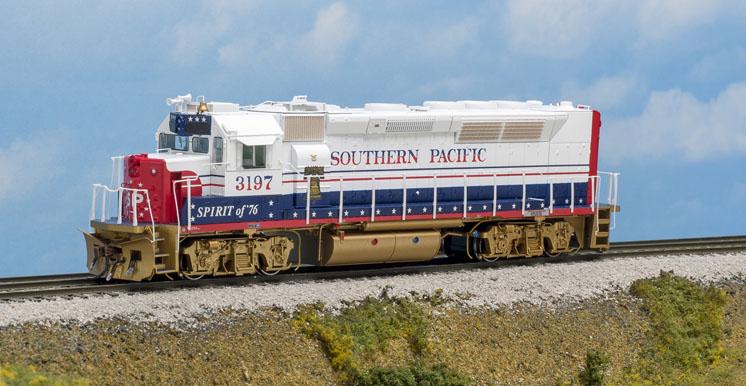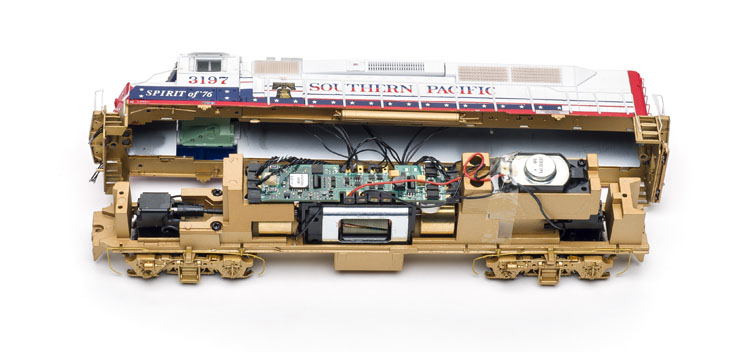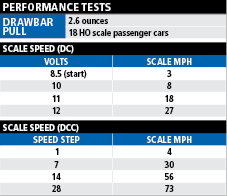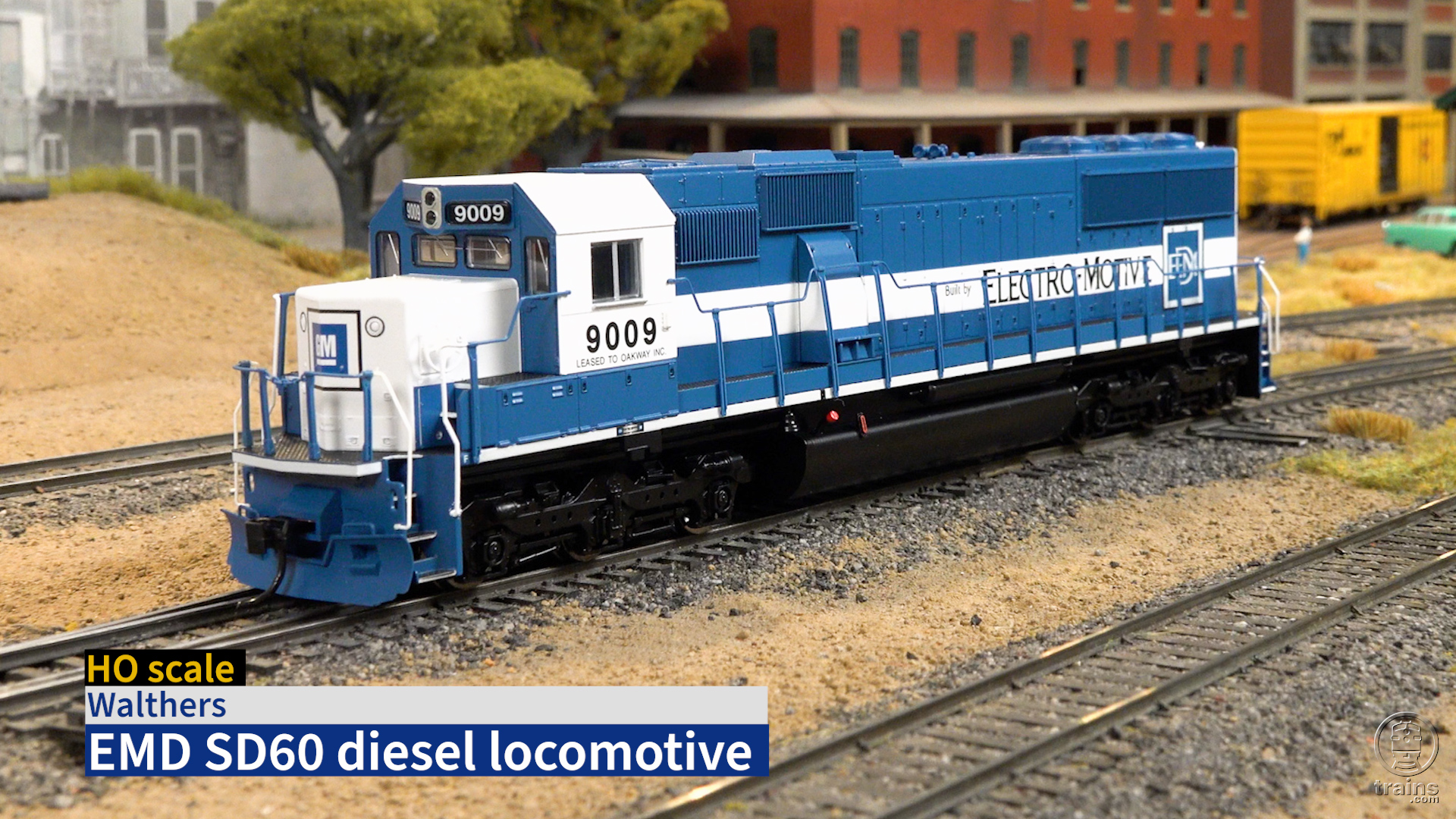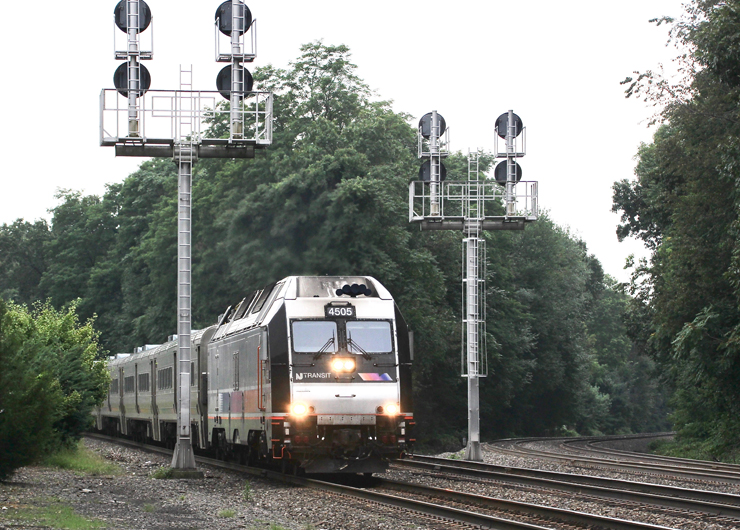No longer solely the province of kitbashers, Electro-Motive Division’s GP40P-2 is available in HO scale from Athearn Trains. Part of the Genesis line of superdetailed locomotive models, this HO scale Geep is especially good news for those modeling Southern Pacific’s “commute” trains of the 1970s and ’80s. Our review sample came equipped with a SoundTraxx Tsunami2 dual-mode sound decoder.
A rare version of a common engine. General Motors’ Electro-Motive Division produced more than 1,100 GP40-2diesel-electric locomotives. The 3,000 hp locomotives were primarily freight haulers. Then in 1974, SP ordered a version with a steam generator to lead trains on its San Francisco-area commute service.
The first (and last) three GP40P-2s were delivered in November 1974, numbered 3197 to 3199 and painted in the SP’s scarlet-and-gray “bloody nose” scheme. In 1976, SP repainted unit 3197 red, white, and blue with gold trucks and underframe to commemorate the nation’s Bicentennial. It wore those colors until 1983, when it was painted scarlet and gray again. A few years later, all three units were renumbered 7600 to 7602, having been demoted to freight duty by the arrival of Caltrain’s F40PHs. The locomotives’ steam generators were removed or disconnected, and their hood openings plated over.
The trio continued to serve SP until 1996, when the railroad merged with Union Pacific. The engines were renumbered once again, 1373 to 1375. But while the first and last of those two serve UP today, no. 1374 – the former Bicentennial unit – was sold to Indiana Harbor Belt, which renumbered it 4010.
Athearn offers its GP40P-2 in SP’s Bicentennial and scarlet-and-gray schemes, as well as in the UP’s Armour Yellow and Harbor Mist Gray. The UP and renumbered SP models have plated-over steam generators and larger fuel tanks than the SP passenger versions.
Outside and in. Wire grab irons and conduits, etched-metal fan grills and windshield wipers, and flexible plastic m.u. lines and handrails are among the model’s separately applied details.
All the measurements I checked matched prototype drawings published in the December 1986 Railroad Model Craftsman. The model’s details and graphics matched prototype photos.
The model’s paint scheme features sharp color separation. The tiny white stars where the red and blue halves of the large letters meet and other small printing were perfectly reproduced.
The five-pole, skew-wound motor and dual brass flywheels are nestled into a notch in the bottom of the die-cast metal frame; driveshafts transfer power to gear towers on both trucks. The Tsunami2 DCC decoder is mounted above the motor. A speaker points downward from its enclosure above the rear gear tower.
On the test track. I first tested the locomotive under direct current. Sounds responded with a realistic startup sequence when track voltage reached 7V. The model didn’t start to move, though, until I applied 8.5V to the rails, rolling at 3.2 scale mph. The engine reached 27 scale mph at 12V and topped out at 37 scale mph at my power pack’s maximum voltage of 13.5V. This speed is lower than the prototype’s top speed of 83 mph when geared for passenger use.
The only sound effects in DC were automatic ones. In addition to the diesel motor, which ramped up and down with the throttle, there was also a barely audiable rail clickety-clack. I liked that when I lowered the voltage between 6V and 7V, the decoder played a shutdown sequence, rather than just stopping.
Under Digital Command Control, the engine’s speed curve was much more prototypical. It started at 4 scale mph, and topped out at 73 scale mph.
One lighting effect I hadn’t noticed on another locomotive before this one: Pushing the DCC throttle’s “Emergency Stop” key not only stops the locomotive, it also triggers the nose-mounted red emergency beacon.
DCC tricks. I wanted to try out all the fancy braking modes senior editor Dana Kawala is always raving about, so after programming momentum values of 50 into Configuration Variable (CV) 2 (acceleration) and CV3 (deceleration),
I programmed 150 into CV116 (independent brake), CV117 (dynamic brake), and CV118 (train brake). I then tried in vain to trigger the braking effects, until Dana pointed out that I hadn’t enabled that feature by programming indexed CV1.403 to 0. Once I did so, function key F12 triggered the train brakes as advertised, gradually bringing the train to a squealing stop. Releasing the brakes brought it back up to speed.
The decoder had the steam generator sound effect programmed for function key F20. Since F6 wasn’t used by our model, I remapped the steam generator sound to that key, making it easy to toggle with one press.
I also programmed the long address to the cab number. For more programming tips, a free Tsunami2 manual is available for download at www.soundtraxx.com.
In our real-world hill-climb test, the engine pulled five passenger cars up a 3 percent grade without slipping. On the way back down, it was fun to push F4, hear the dynamic brakes kick in, and watch the locomotive actually slow by the amount I’d programmed.
As good as it gets. Each new generation of decoders brings the operational capabilities of our models that much closer to those of the prototype. With SoundTraxx’s new Tsunami2 decoder and Athearn’s smooth-running Genesis drivetrain wrapped in an accurately modeled exterior, who could ask for more?
Manufacturer
Athearn
1600 Forbes Way, Suite 120
Long Beach, CA 90810
www.athearn.com
Era: 1976 to 1983 as decorated for Southern Pacific no. 3197
Road names: Southern Pacific (Bicentennial scheme, one number; “bloody nose” scheme, four numbers), Union Pacific (two numbers)
Features
• Blackened metal RP-25-contour wheels, in gauge
• Cab interior with movable cab windows
• Directional light-emitting-diode lighting
• Five-pole, skew-wound motor with dual brass flywheels
• Minimum radius: 18″
• Plastic McHenry knuckle couplers, at correct height
• SoundTraxx Tsunami2 DCC decoder or DCC-ready with 21-pin QuickPlug
• User-installed train number decals
• Weight: 13.8 ounces





